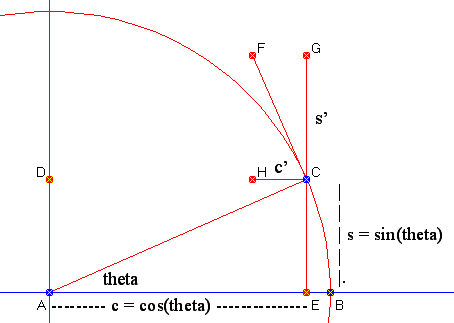

It would be slightly more satisfying to set theta = f(t), where t is the time variable, but since dtheta/dt cancels out it doesn’t matter.
besides, this would require the dy/dx form of the derivative, and this seems to have gone out of fashion – poor Leibniz

Thanks for pointing me to that post in your reply on my blog!
Since you asked – I don’t see any loopholes! I consider this proof similar to starting from describing the path of the point as a complex number by e^(i*theta) with theta being some function of t. Of course it depends on what you want to accept as an existing rule. Assuming we know about complex numbers (or vectors in a 2D plane), the exponential function, its derivative and e^(i*theta) = cos theta + i * sin theta:
r(t) = e^(i*theta(t)) (1)
(r being complex)
Then the velocity is
v(t) = i*theta'(t) * e^(i*theta(t)) (2)
Perhaps if you want to avoid the requirement of knowing about the derivative of the exponential function you could also say: in a circular path r and v have to be perpendicular to each other, thus there needs to be a factor e^(i*pi/2) or simply i (i * sin Pi/2) to get from r to v.
(1) =>
r(t) = cos(theta) + i * sin(theta)
v(t) thus is also
r'(t) = theta'(t)*cos'(theta) + i * theta(t)*sin(theta(t))
= theta'(t)[cos'(theta) + i * sin'(theta(t)]
Comparing that to inserting the definition of exp = sin + i * cos into (2)…
v(t) = i * theta'(t) [cos(theta) + i * sin(theta)]
Rearraning real and imaginary parts:
v(t) = theta'(t )[-sin(theta) + i*cos(theta)]
Comparing real and imaginary parts:
cos’ = -sin and sin’ = cos.
So theta can be any function of t and cancels out. If you wanted to add a function theta(t) you could also multiply both terms in your Eq.1 with theta’ as the derivative of cos^2(theta(t)) is 2*cos(theta)*theta'(t).
Sorry in advance for any typos – I am always a bit reluctant to add derivations to comments on other blogs as I don’t have a chance to correct them later.